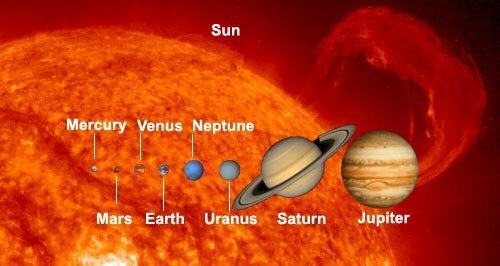Classification of Planets by Size From Biggest to Smallest
The solar system has 8 planets, each of them is sorted in this classification planets by size according to its diameter in kilometers and miles, from the largest to the smallest and vice versa. We note that the smallest planet in the solar system could fit about 30 times inside the largest. Read also: The order of the planets closest to the sun
8 ranked planets
Sort by :
Increasing diameter
1st – Jupiter
139,820 km (86,880.12 miles)
Jupiter is a giant gas planet in the solar system. It is 318 times more massive than Earth and about 1300 times larger than it … more info and comments
Jupiter, the largest planet in our solar system, is a colossal gas giant with a diameter of about 86,881 miles (139,822 kilometers). Its immense size is over 11 times that of Earth, and it contains more than twice the mass of all the other planets combined. Jupiter’s iconic swirling bands of clouds and its mesmerizing Great Red Spot are testaments to its turbulent atmosphere. While its size and gravity would make life impossible, Jupiter plays a vital role in shaping the dynamics of our solar system, acting as a gravitational shield against many cosmic threats.
2nd – Saturn
116,460 km (72,364,889 miles)
Saturn is a giant gas planet in the solar system. It is 95 times more massive than the Earth and about 760 times more voluminous … more info and comments
Saturn is the second-largest planet, boasting a diameter of approximately 72,367 miles (116,464 kilometers). Known for its breathtaking ring system, Saturn’s rings are composed of icy particles ranging in size from tiny dust grains to large boulders. The planet’s rings are visible even from Earth with a telescope, adding to its allure. Saturn’s stunning appearance, along with its vast system of moons, contributes to our understanding of planetary formation and evolution.
3rd – Uranus
50,724 km (31,518.43 miles)
Uranus is a giant ice planet in the solar system. It is almost 15 times more massive than the Earth and yet about 16 times less bulky than it … more info and comments
Uranus, an ice giant, is the third-largest planet in our solar system, with a diameter of about 31,518 miles (50,724 kilometers). Its most striking feature is its extreme axial tilt, making it appear as if it rotates on its side. Uranus is primarily composed of water, methane, and ammonia, and its frigid atmosphere is adorned with faint rings and a collection of unique moons. Despite its size, Uranus remains a mysterious and relatively unexplored world, sparking curiosity about its peculiar characteristics.
4th – Neptune
49,244 km (30,598.80 miles)
Neptune is a giant ice planet in the solar system. It is almost 20 times more massive than the Earth while it is almost 20 times less bulky … more info and comments
Neptune, the fourth-largest planet, has a diameter of around 30,599 miles (49,244 kilometers). Known for its vivid blue color, Neptune is an ice giant with a dynamic atmosphere featuring massive storms and fast winds. It completes a full orbit around the Sun in about 165 Earth years. Its moon, Triton, is one of the coldest known objects in our solar system, showcasing the diversity of conditions within the outer reaches of our cosmic neighborhood.

The eight planets of the Solar System with size to scale (up to down, left to right): Saturn, Jupiter, Uranus, Neptune (outer planets), Earth, Venus, Mars, and Mercury (inner planets). CactiStaccingCrane, CC BY-SA 4.0, via Wikimedia Commons
5th – Earth
12742km (7,917.51 miles)
Earth is a terrestrial planet in the solar system. It was formed 4.54 billion years ago and life appeared less than a billion years later … more info and comments
Earth, our home, is the fifth-largest planet, with a diameter of about 7,917 miles (12,742 kilometers). As the only known planet to support life, Earth’s size is just right to provide a comfortable environment for diverse ecosystems to thrive. Its atmosphere and magnetic field protect us from harmful solar radiation, and its varied landscapes, oceans, and atmosphere make it a unique and vibrant world.
6th – Venus
12,104 km (7,521.07 miles)
Venus is a terrestrial planet in the solar system. It is slightly lighter and smaller than the Earth … more info and comments
Venus, often called Earth’s “sister planet,” is the second planet from the Sun and nearly the same size as Earth, with a diameter of about 7,520 miles (12,104 kilometers). However, that’s where the similarities end. Venus is a scorching inferno with surface temperatures that can reach up to 900 degrees Fahrenheit (475 degrees Celsius), making it the hottest planet in our solar system. Its thick atmosphere is primarily composed of carbon dioxide and traps heat, creating a runaway greenhouse effect. The surface is dotted with numerous volcanoes, vast lava plains, and high mountains, making Venus a geologically active world. While its size and composition make it somewhat similar to Earth, Venus’ extreme temperatures and hostile atmosphere render it uninhabitable.
7th – Mars
6,779 km (4,212.27 miles)
Mars is a terrestrial planet in the solar system. It is about 9 times lighter than the Earth and almost 7 times smaller than it … more info and comments
Mars, often called the “Red Planet” due to its reddish appearance, is the fourth planet from the Sun and has a diameter of approximately 4,212 miles (6,779 kilometers). Mars is known for its intriguing landscape, featuring massive volcanoes, deep canyons, and ancient river valleys, indicating the presence of liquid water in the distant past. Its thin atmosphere is mostly carbon dioxide, and its polar ice caps are composed of water and frozen carbon dioxide. Scientists continue to explore Mars for signs of past or present life, as its conditions, though harsh, are considered more hospitable than other planets. The quest to understand Mars also holds the key to potential future human exploration and colonization beyond Earth.
8th – Mercury
4,879.4 km (3,031.91 miles)
Mercury is a terrestrial planet in the solar system. It is 18 times lighter than the Earth and 18 times less bulky … more info and comments
Mercury, the smallest planet in our solar system, has a diameter of about 3,032 miles (4,879 kilometers). As the closest planet to the Sun, Mercury experiences extreme temperature variations, with surface temperatures ranging from scorching highs of around 800 degrees Fahrenheit (427 degrees Celsius) during the day to freezing lows at night due to its lack of atmosphere to retain heat. Despite its small size, Mercury boasts a dense iron core, making it one of the most metal-rich planets in our solar system. The planet’s surface is heavily cratered, evidence of its tumultuous history of impacts from space debris. Mercury’s proximity to the Sun makes it a challenging destination for exploration, but studying it helps us better understand the formation and evolution of rocky planets like Earth.

Planets by Size From Smallest to Biggest
8 ranked planets
Sort by :
Increasing diameter
8th – Mercury
4,879.4 km (3,031.91 miles)
Mercury is a terrestrial planet in the solar system. It is 18 times lighter than the Earth and 18 times less bulky … more info and comments
Mercury | Planet’s characteristics, distance to Earth, color, composition, peculiarity
7th – Mars
6,779 km (4,212.27 miles)
Mars is a terrestrial planet in the solar system. It is about 9 times lighter than the Earth and almost 7 times smaller than it … more info and comments
Mars | Planet’s characteristics, distance to Earth, color, composition, peculiarity
6th – Venus
12,104 km (7,521.07 miles)
Venus is a terrestrial planet in the solar system. It is slightly lighter and smaller than the Earth … more info and comments
Venus | Planet’s characteristics, distance to Earth, color, composition, peculiarity
5th – Earth
12742km (7,917.51 miles)
Earth is a terrestrial planet in the solar system. It was formed 4.54 billion years ago and life appeared less than a billion years later … more info and comments
Earth | Planet’s characteristics, distance to Earth, color, composition, peculiarity
4th – Neptune
49,244 km (30,598.80 miles)
Neptune is a giant ice planet in the solar system. It is almost 20 times more massive than the Earth while it is almost 20 times less bulky … more info and comments
Neptune | Planet’s characteristics, distance to Earth, color, composition, peculiarity
3rd – Uranus
50,724 km (31,518.43 miles)
Uranus is a giant ice planet in the solar system. It is almost 15 times more massive than the Earth and yet about 16 times less bulky than it … more info and comments
Uranus | Planet’s characteristics, distance to Earth, color, composition, peculiarity
2nd – Saturn
116,460 km (72,364,889 miles)
Saturn is a giant gas planet in the solar system. It is 95 times more massive than the Earth and about 760 times more voluminous … more info and comments
Saturn | Planet’s characteristics, distance to Earth, color, composition, peculiarity
1st – Jupiter
139,820 km (86,880.12 miles)
Jupiter is a giant gas planet in the solar system. It is 318 times more massive than Earth and about 1300 times larger than it … more info and comments
Planet Distance to Sun | How Far Are The Planets From The Sun?
Conclusion
Each planet in our solar system is a remarkable celestial body, offering insights into the diverse conditions and formations found throughout the universe. From the massive gas giants like Jupiter and Saturn to the ice giants Uranus and Neptune, and finally, to our own habitable and dynamic home, Earth, the study of these planets enriches our understanding of the cosmos and our place within it.
Photo credit: Wikimedia Commons, PinterPandai, Universe Today, NASA
Photo explanations: This picture compares the sizes of the Sun and the planets. If Earth were about 2 millimeters across, as it is in this picture, the Sun would be almost 218 millimeters (about 8-1/2 inches) across!



